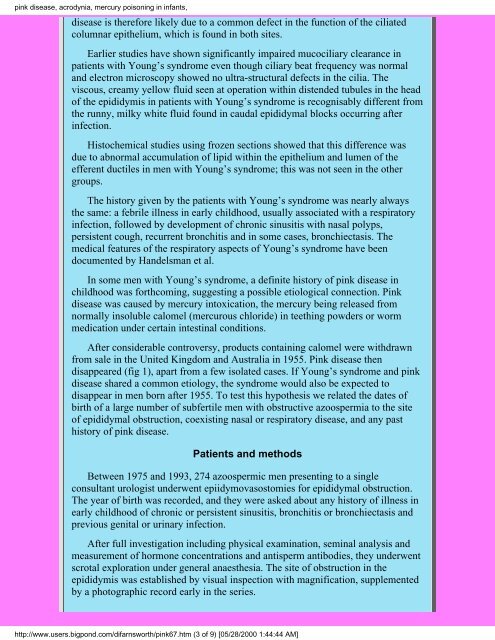You also want an ePaper? Increase the reach of your titles
YUMPU automatically turns print PDFs into web optimized ePapers that Google loves.
pink disease, acrodynia, mercury poisoning in infants,disease is therefore likely due to a common defect in the function of the ciliatedcolumnar epithelium, which is found in both sites.Earlier studies have shown significantly impaired mucociliary clearance inpatients with Young’s syndrome even though ciliary beat frequency was normaland electron microscopy showed no ultra-structural defects in the cilia. Theviscous, creamy yellow fluid seen at operation within distended tubules in the headof the epididymis in patients with Young’s syndrome is recognisably different fromthe runny, milky white fluid found in caudal epididymal blocks occurring afterinfection.Histochemical studies using frozen sections showed that this difference wasdue to abnormal accumulation of lipid within the epithelium and lumen of theefferent ductiles in men with Young’s syndrome; this was not seen in the othergroups.The history given by the patients with Young’s syndrome was nearly alwaysthe same: a febrile illness in early childhood, usually associated with a respiratoryinfection, followed by development of chronic sinusitis with nasal polyps,persistent cough, recurrent bronchitis and in some cases, bronchiectasis. Themedical features of the respiratory aspects of Young’s syndrome have beendocumented by Handelsman et al.In some men with Young’s syndrome, a definite history of pink disease inchildhood was forthcoming, suggesting a possible etiological connection. Pinkdisease was caused by mercury intoxication, the mercury being released fromnormally insoluble calomel (mercurous chloride) in teething powders or wormmedication under certain intestinal conditions.After considerable controversy, products containing calomel were withdrawnfrom sale in the United Kingdom and Australia in 1955. Pink disease thendisappeared (fig 1), apart from a few isolated cases. If Young’s syndrome and pinkdisease shared a common etiology, the syndrome would also be expected todisappear in men born after 1955. To test this hypothesis we related the dates ofbirth of a large number of subfertile men with obstructive azoospermia to the siteof epididymal obstruction, coexisting nasal or respiratory disease, and any pasthistory of pink disease.Patients and methodsBetween 1975 and 1993, 274 azoospermic men presenting to a singleconsultant urologist underwent epiidymovasostomies for epididymal obstruction.The year of birth was recorded, and they were asked about any history of illness inearly childhood of chronic or persistent sinusitis, bronchitis or bronchiectasis andprevious genital or urinary infection.After full investigation including physical examination, seminal analysis andmeasurement of hormone concentrations and antisperm antibodies, they underwentscrotal exploration under general anaesthesia. The site of obstruction in theepididymis was established by visual inspection with magnification, supplementedby a photographic record early in the series.http://www.users.bigpond.com/difarnsworth/pink67.htm (3 of 9) [05/28/2000 1:44:44 AM]


